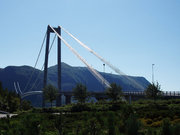Krifast
|
|

KRIFAST is the name of the road system connecting the city of Kristiansund and the islands of Frei, Bergsøya and Aspøya to the mainland of Møre og Romsdal, Norway, giving 22,000 people a connection to the mainland. The most famous parts are the underwater tunnel and two of the bridges. 25 km (15.5 mi) of road and 6 km (3.5 mi) of pedestrian and bike road are also counted as part of KRIFAST, which was opened in 1992.
A total of 7 bridges are part of KRIFAST, the most famous one being the suspension bridge Gjemnessundbrua from Bergsøya to Gjemnes, with 108 m (354 ft) high towers and a span between them of 623 m (2,044 ft). There is also the 933 m (.6 mi) long pontoon bridge Bergsøysundet flytebru from Bergsøya to Aspøya, which is the only bridge of its kind where nothing but the ends are anchored to solid rock. The bridge is supported by 7 pontoons, floating on a 320 m (1,050 ft) deep fjord.
The 5.1 km (3.2 mi) long underwater tunnel goes under the fjord Freifjorden. It is 134 m (440 ft) below sea-level at the deepest, though the bottom 35 m (115 ft) is solid rock. A drive through the tunnel takes about 5 minutes. Because of the relatively steep climb there are three lanes at each end, but only two at the bottom.
KRIFAST was decided built by the Norwegian parliament, the Storting, in 1985, and construction began in October 1988. The government pledged to finance 39% of the expences, the rest were to be taken in as toll on road traffic and car ferry fares (on the ferries to be obsoleted by the tunnel and bridges). As of July 1991, the project employed 427 people, and spent 2 million Norwegian kroner (about US$300,000) daily on construction. Four years and 1.1 billion kroner ($160 million) later, in August 1992, KRIFAST was opened for regular traffic.
Categories: Roads | Nordmøre | Kristiansund | Norway
